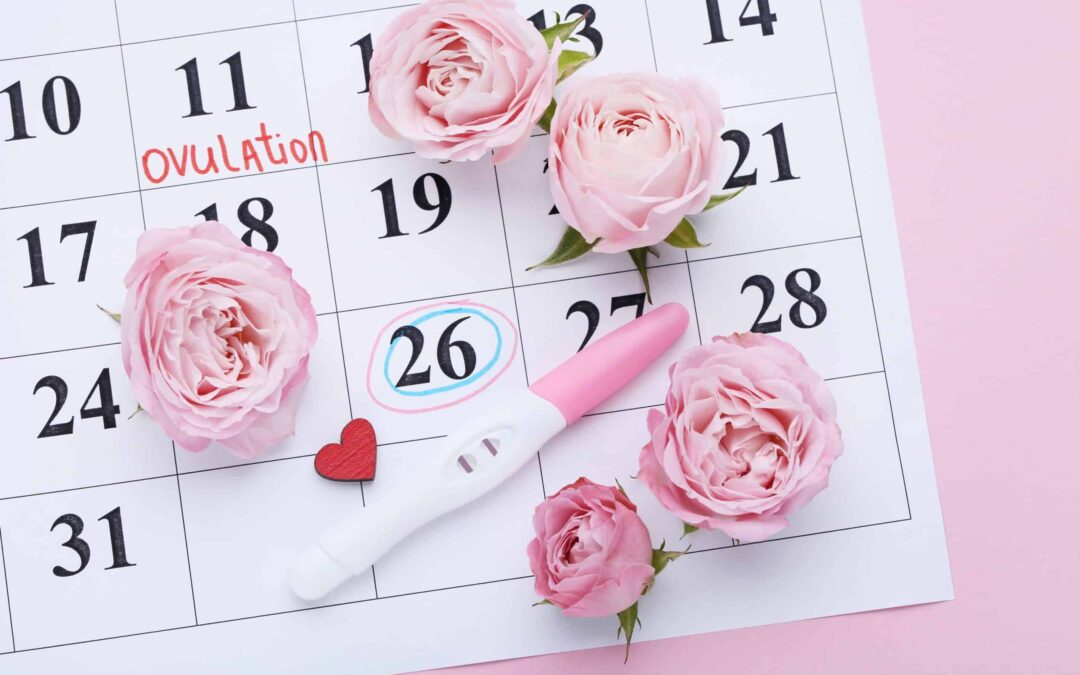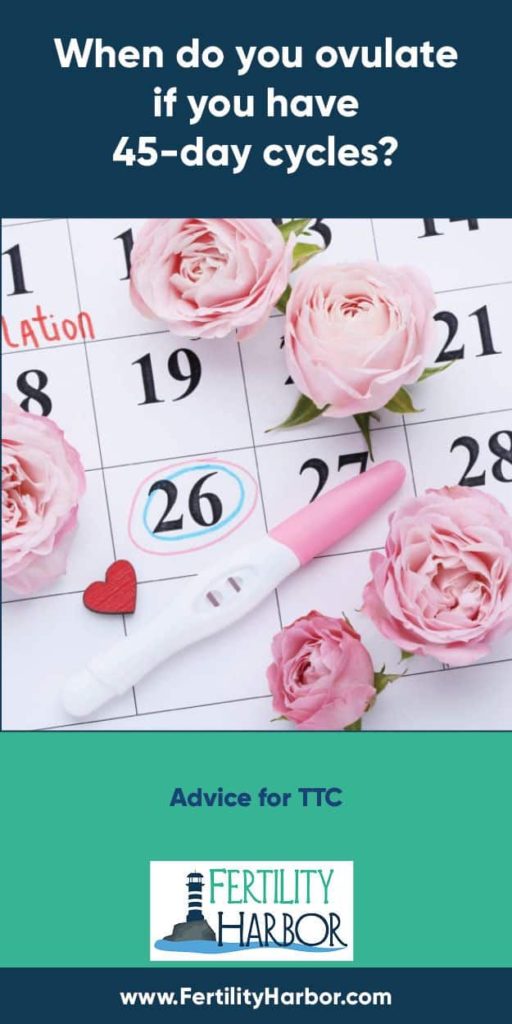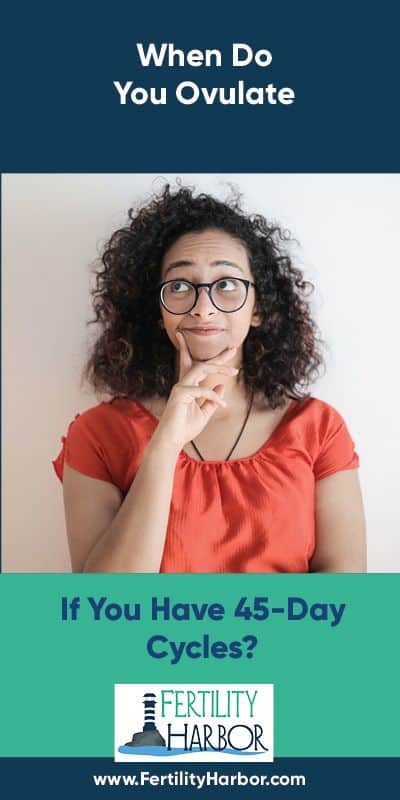This post was reviewed for medical accuracy by Rosalie Gunson, a Certified Registered Nurse Practitioner specializing in fertility care.
Figuring out when — and if! — you ovulate is absolutely fundamental to the whole TTC effort. Without ovulation there is literally no chance of conceiving, so becoming familiar with your body’s patterns and rhythms is vital.
You might remember from health class that a menstrual cycle is 28 days, and ovulation happens on day 14. The most fertile days are the ovulation day itself and a few days before (CD 12-14).
But that’s the textbook cycle, and in the real world, our bodies don’t care what the textbook says. Instead of 28 days, your cycles may be 30 days or 32 days. They could be even longer.
When do you ovulate if your cycle is 45 days long? It’s hard to say. Unfortunately, cycles that long can indicate that you’re not ovulating, or at least not ovulating “well” (with high-quality eggs and a nice thick uterine lining).
My ob/gyn considered 35 days to be the upper limit for a healthy menstrual cycle for conception.
The Textbook Menstrual Cycle
Even though all women do not follow this pattern, it’s helpful to understand how the textbook 28-day cycle works. Here’s what happens when your body is polite enough to follow the instruction manual:
- Day 1: The first day of your period (your body begins shedding the uterine lining from the previous cycle)
- Days 1-14: The follicular phase (follicles are growing and estrogen is rising)
- Days 12-14: The optimal fertile window
- Day 14: Ovulation (the dominant follicle releases its egg)
- Days 15-28: The luteal phase (progesterone rises, and then begins to drop if not pregnant). This is what is commonly referred to as the Two-Week Wait (abbreviated online as 2WW or TWW).
- Day 1 (what would have been Day 29): The first day of your next period, if not pregnant.
So what about healthy, ovulatory cycles that are more like 30 or 32 days? Generally speaking, the luteal phase is a consistent length from cycle to cycle (14, 15, or 16 days). It’s the follicular phase — the time between your period and ovulation — that would be longer in longer cycles. In other words, you’d ovulate after CD 14.
If you’re thinking, “Wow, I never really learned how this works!” you’re not alone. I didn’t either! Do yourself a favor and get a copy of Taking Charge of Your Fertility (Amazon affiliate link). It’s a classic resource that explains all the stuff women should know about our own bodies, but often weren’t taught in school.
There’s actually a movement to get regular cycles recognized as an important indicator of overall health for girls and women. For more info, see Should Regular Periods Be Considered a Vital Sign?
How to Know If and When You’re Ovulating
There are a few ways to know if you’re ovulating, although some of them come with caveats.
1) Ovulation predictor kits (OPKs)
You can buy OPKs in any drugstore or Target. Ovulation predictor kits measure the surge in luteinizing hormone (LH) that indicates your body is gearing up for ovulation.
They work in a similar way to home pregnancy tests (in other words, you pee on them). Depending on the brand, a second line or a smiley face will tell you that you will ovulate soon.
I personally never used OPKs because I didn’t trust them to be accurate for me. Women with PCOS can experience LH surges without actually ovulating. That would make the OPK show a false positive.
But OPKs can be a useful tool for women with less wonky cycles, especially if they are used in conjunction with other strategies (like temping).
2) Cervical mucus (CM), also called cervical fluid
If you’ve spent any time Googling fertility stuff, you have probably come across the phrase “egg white cervical mucus” or EWCM. It’s clear and slippery, just like egg whites.
Women who are not used to good ovulatory cycles (such as women coming off long-term birth control) may be taken by surprise the first time they see EWCM. It’s caused by the mature follicle(s) producing higher levels of estrogen.
EWCM shows up during your fertile window, to help those swimmers get where they need to go. The absence of EWCM doesn’t necessarily mean that you’re not ovulating, but the presence of it is definitely a promising sign.
If you see EWCM, tell your partner to leave work early — you’ve got business to take care of!
(That’s assuming you’re trying to get pregnant. If you’re not interested in a pregnancy and you’re not using some form of birth control, you should definitely abstain on the days that you have EWCM!)
3) Temping
Temping involves taking your basal body temperature (BBT) every morning before you get out of bed. You may have also seen this called “charting,” because some women keep a record of their temperatures and look for patterns. Apps like Fertility Friend are handy for keeping track of this.
What’s the point of doing this? Well, your body temperature changes throughout your cycle. The morning after you ovulate, your temperature should rise between 0.5 and 1 degree F and stay up.
Your temperature will drop back down as you prepare to get your period, but it will remain high if you’re pregnant.
You will need a thermometer that is accurate to a tenth of a degree F in order to do this properly. Here’s a good digital basal body thermometer you can get on Amazon (affiliate link). You can find this and other essential products for TTC in Infertility Starter Pack.
One drawback of temping is that it just indicates that you already ovulated. It’s not really useful for pinpointing ovulation ahead of time, unless you have been carefully charting your temps over several months and you have predictable cycles.
But if you’re a data-oriented person, basal body temperature is an interesting thing to track. Yay for science!
If you do decide to start temping, try not to obsess. Some women track their temps for years with no success, when they’d be better off talking to a doctor.
4) Blood tests
Lab tests can shed some light on what is happening, although a blood test only captures one moment in time. You may need multiple tests before a meaningful picture emerges.
For example, fertility specialists often check progesterone on CD 21/ 7dpo (again, that is based on the textbook 28-day cycle) to see if you ovulated. If you ovulated your result will probably be at least 10 ng/mL, although your doctor may use a different threshold.
Like temping, this is an after-the-fact thing — it doesn’t help you predict ovulation.
5) Trigger shot
Taking a trigger shot, such as Ovidrel, will pretty much guarantee you will ovulate within 24-36 hours. A trigger shot is usually done after an ultrasound has confirmed that you have at least one mature follicle ready to go. The shot makes it easier to time IUIs and/ or intercourse appropriately.
Nervous about getting one of these ultrasounds? Check out Do Transvaginal Ultrasounds Hurt? for reassuring info.
Keep in mind that a trigger shot can affect the results of a home pregnancy test. For more information on that, check out my post Can Ovidrel Cause a False Positive on a Pregnancy Test?
If you’re at the beginning of your fertility journey and you want to know if you’re ovulating, you’re not going to jump right to trigger shots and lab tests. Start with paying attention to your cervical mucus and keeping some sort of record of your periods, even if you’re not ready to start a daily temping routine.
Getting Shorter, Ovulatory Cycles
So what are you supposed to do if you suspect your cycles are too long and you’re not ovulating?
You should definitely talk to your doctor about a fertility workup. Depending on the results, she may start you on Clomid or Femara (letrozole) to see if one of these medications will rev up your ovaries and get you ovulating “well.”
If you haven’t seen a doctor about this yet and don’t know where to start, my post Can My PCP Prescribe Clomid? may be helpful. Are Letrozole and Femara the Same Thing? also has some good info.
Another option that works for some women with PCOS and/ or insulin resistance is Metformin, which is typically used to treat diabetes. I personally hated Metformin due to nasty GI side effects, but a lot of women swear by it.
If you start this process while you’re in a very long cycle (as in, you had your last period a long time ago and you’re not pregnant), your doctor will likely prescribe Provera (a form of progesterone) first.
Provera will induce a period so you can start a fresh cycle. This is typically done with 10 days of pills, although some doctors offer an injection instead to save you some waiting time. I actually wrote a whole post about Provera if you want to learn more.
It’s especially important to get a handle on your ovulation if you’re preparing to TTC in the near future. My post TTC Right After Your Wedding goes into more detail about that.
If you need to have your IUD taken out before you start trying, TTC After IUD Removal: How Soon Can You Get Pregnant? has some useful info as well.
Conclusion
Many women are under the impression that a 45-day cycle is within the normal range. It’s really not, at least if you’re trying to get pregnant. You should aim for cycles of no longer than 35 days to optimize your chances of getting that BFP.
You may be surprised how short a run-of-the-mill menstrual cycle feels when you’re used to long cycles. Once I started having proper ovulatory cycles (thanks to meds), I couldn’t believe how fast each cycle would go by.
I’d obviously be sad after every BFN, but before I knew it, it was time to go in for follicle scans again. I was back in the game!
This post was last updated in May 2020.




 I’m Jenn! Here I am with my beautiful twin boys. My pregnancy was possible thanks to fertility treatment for PCOS.
I’m Jenn! Here I am with my beautiful twin boys. My pregnancy was possible thanks to fertility treatment for PCOS.


